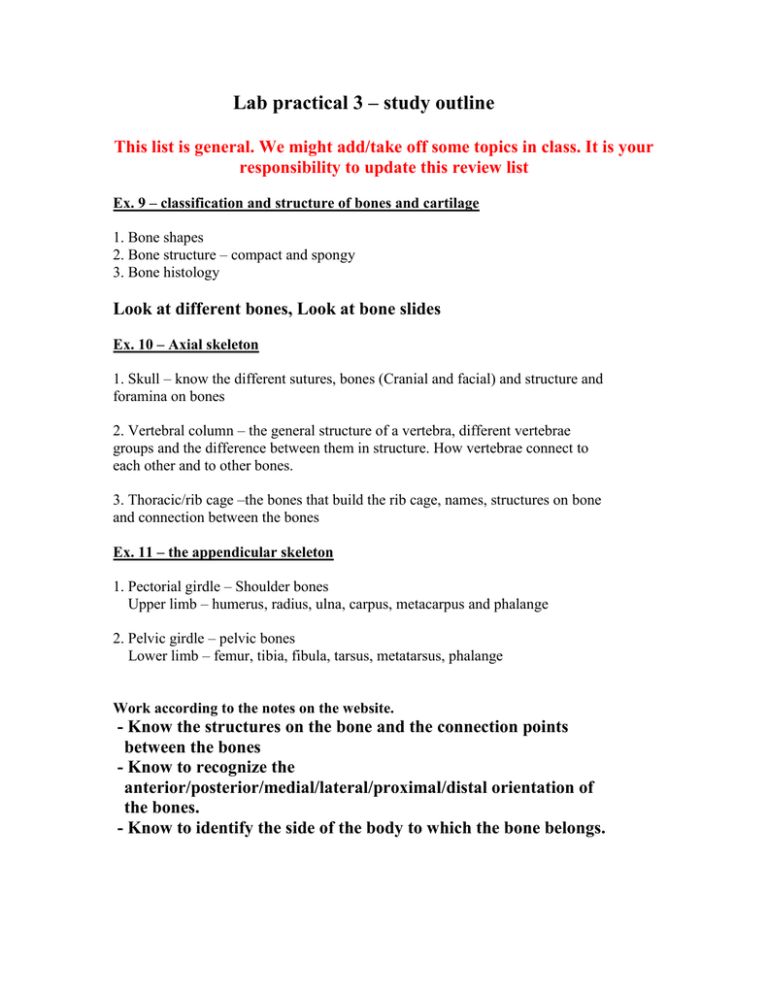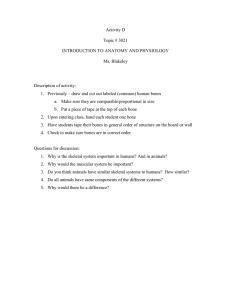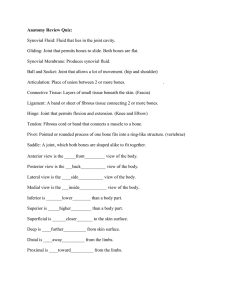Lab practical 3 – study outline
advertisement

Lab practical 3 – study outline This list is general. We might add/take off some topics in class. It is your responsibility to update this review list Ex. 9 – classification and structure of bones and cartilage 1. Bone shapes 2. Bone structure – compact and spongy 3. Bone histology Look at different bones, Look at bone slides Ex. 10 – Axial skeleton 1. Skull – know the different sutures, bones (Cranial and facial) and structure and foramina on bones 2. Vertebral column – the general structure of a vertebra, different vertebrae groups and the difference between them in structure. How vertebrae connect to each other and to other bones. 3. Thoracic/rib cage –the bones that build the rib cage, names, structures on bone and connection between the bones Ex. 11 – the appendicular skeleton 1. Pectorial girdle – Shoulder bones Upper limb – humerus, radius, ulna, carpus, metacarpus and phalange 2. Pelvic girdle – pelvic bones Lower limb – femur, tibia, fibula, tarsus, metatarsus, phalange Work according to the notes on the website. - Know the structures on the bone and the connection points between the bones - Know to recognize the anterior/posterior/medial/lateral/proximal/distal orientation of the bones. - Know to identify the side of the body to which the bone belongs. Ex. 13 – articulations 1. Joints classification – by movement (diarthrosis, amphioarthrosis, syarthrosis), by the connection between bones (fibrous, cartilaginous, synovial). 2. The general structure of synovial joint – articular capsule, synovial membrane, synovial cavity and fluid, articular cartilage, ligaments, articular discs 3. Different types of synovial joints (gliding, hinge, pivot, condyloid, saddle, ball and socket – fig 13.4 for examples). 4. Movement of synovial joints 5. Structure of the knee joint Look at joints models, look at bones and identify types of articulations and movements Ex. 15 – gross anatomy of the muscular system Names of human muscles, location, origin, insertion, function Know to identify muscles in the cat Look at muscle models and cats Ex. 14 – microscopic anatomy and organization of the skeletal muscle. 1. Microscopic anatomy – myofibrils, I and A bands, microfilaments, actin and myosin, sarcomer, Z disc 2. Organization of a skeletal muscle – endomysium, perimysium, fascicle, epimysium Look at a cross section of smooth, cardiac and skeletal muscle slides and models



